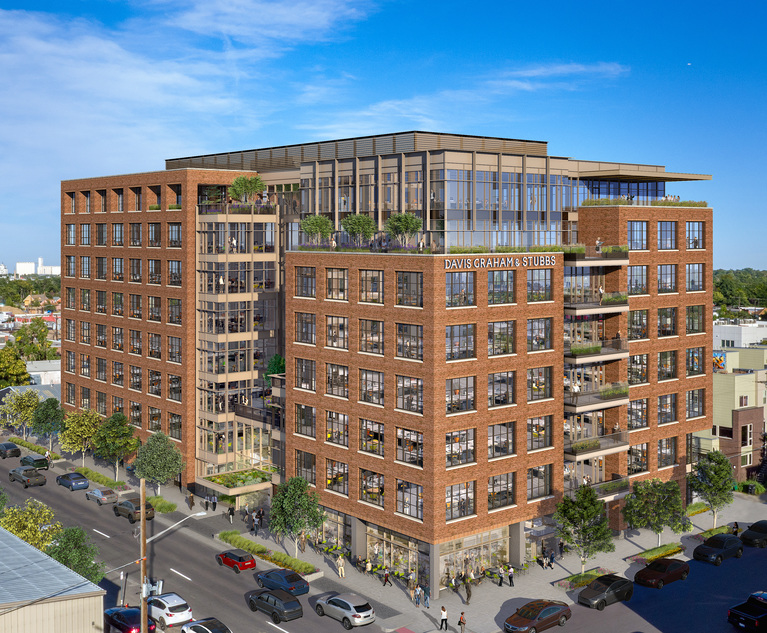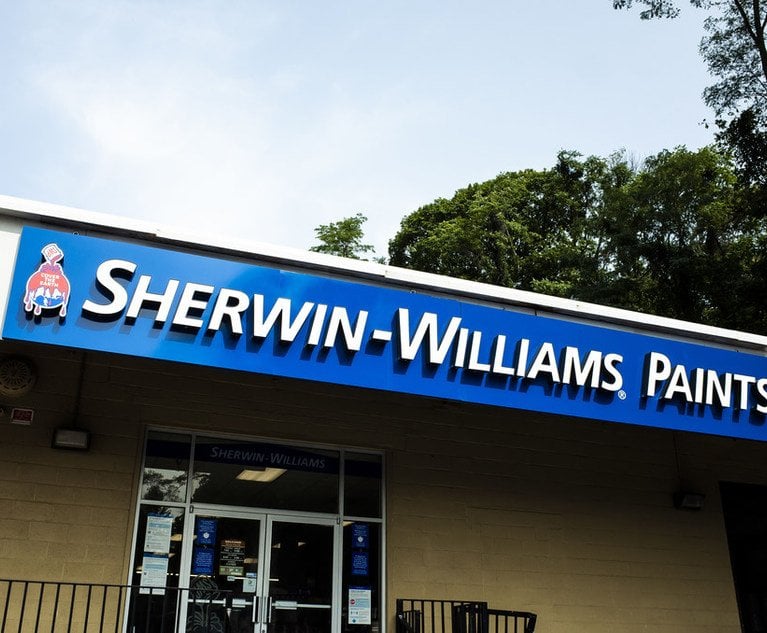'If You Don't Have 100% Capacity, It Feels Lethargic': Law Firms Are Trading Dead Space for New Digs
Farella Braun + Martel, Sherman & Howard and Davis Graham & Stubbs are just a few of the law firms in the West downsizing and upgrading their office space.
June 17, 2022 at 01:45 PM
5 minute read
What You Need to Know
- Law firms returning to work in a hybrid manner are increasingly opting for office relocations.
- Firms are flocking to newer buildings in the hopes of preserving their identity and community vibe.
 Rendering of Davis Graham & Stubbs' new office in Denver. Credit: Sam Adams / Adams Visual Communiations[/caption] Law firms are increasingly opting for relocations rather than renewals, as firms look to sell talent on their unique identity and flexible approach to work. In recent weeks, three midsize firms in the West have relocated or announced upcoming relocations that move them out of their homes of 20 years or more, into smaller footprints in newer buildings that firm leaders say are better designed for the hybrid legal practice of the future. Northern California midsize firm Farella Braun + Martel, which celebrated its 60th anniversary as a firm this year, is taking the plunge after more than 50 years at the Russ Building office tower in the heart of the San Francisco Financial District. The firm recently signed a lease at 1 Bush St. (just a three-minute walk from its current building), which will reduce Farella Braun's footprint from 125,000 square feet to 40,000 square feet come mid-2023. "This was a chance to look at, 'Are we in the right space for the future?'" Farella Braun managing partner Brian Donnelly said, noting that the timing of the firm's lease expiration was particularly fortunate in light of the pandemic and transition to hybrid work. "We put together a space committee and got input from partners, and we found that people didn't want a cookie-cutter class A building," Donnelly said. "They wanted a place with the historic charm of the Russ Building, but also a space that would give them a better chance to see each other in the office." Donnelly noted that because the Russ Building was designed for a different time, the firm has excess spaces such as secretarial stations that are no longer utilized. Another highlight of the new space, he said, is that the firm will have two floors connected via an internal staircase that will promote a better flow of encounters in the office. The firm has also adopted hoteling or office-sharing and plans to continue to allow for hybrid and flexible work for its attorneys as well as staff members. Sherman & Howard, Denver's oldest law firm, had a similar story to tell about its recent office overhauls and its aim to foster collaboration. The firm moved out of its 47-year-old home in March, relocating to an office about half the size at 60,000 square feet, as the anchor tenant of a newly constructed 30-story office building in downtown Denver called Block 162. "It's a completely new building, and as the first tenant we've been a trailblazer, with lots of people following us into the space," said Sherman & Howard CEO Stefan Stein. "We reduced our footprint by 50%, and we're on two floors, which encourages people to interact, cross-sell and collaborate." Since the move, several other firms have signed leases in the building including Denver's Brownstein Hyatt Farber Schreck, Haynes and Boone and Lathrop GPM. As part of the firm's vision to create a "one-firm mindset" that is welcoming and inclusive, according to Melissa Reagan, member and chair of talent acquisition at Sherman & Howard, the firm adopted single-sized offices and designated corner offices as huddle or meeting rooms, while increasing community event spaces and adding an internal café. The office also signals that the firm is "very much embedded in the community" internally and externally, Stein said, noting the building offers views of the mountains, the state capitol and the Denver Broncos stadium, and keeps the firm in close proximity to local clients. "There's not a bad view of Denver from my office," Stein said, noting that though the firm is encouraging lawyers to come in at least 50% of the time, it recognizes that hybrid work is necessary to compete for all ranks of lawyers and staff. Meanwhile, in Arizona, the firm this month combined two offices (acquired via a merger with Mohr, Hackett, Pederson, Blakley & Randolph in 2009 into one space in the Biltmore area of Phoenix, with the aim to reinvigorate and grow the team. Fellow Denver-born firm Davis Graham & Stubbs has also opted for new digs, setting a plan in motion to move into 80,000 square feet at a new development called Paradigm River North in 2024. The firm will move from the west end of Denver's central business district to lower downtown or LoDo, an area of downtown that has bustled with development activity in the last five years, according to Davis Graham co-managing partner Kristin Lentz. The move is both "aggressive and progressive," according to Lentz, and reflects similar steps that the firm took nearly 20 years ago when it relocated to the west end of downtown. "Our ultimate goal is to provide great service to clients and to do that we want to attract and retain the very best high-quality lawyers. We felt this would be a good move that differentiates us from the competition," Lentz said. Davis Graham was particularly attracted to the "neighborhood feel" of the area and the smaller building, with just eight stories, which will allow the firm to preserve its identity in the community, she said, noting the building also offers a fair amount of outdoor terrace space. Lentz added that as the firm returns to work, with the ask that attorneys are in the office about 50% of the time, the new space will make it easier to host creative events and get-togethers. "We have a lot of dead space in our current office, and if you don't have 100% capacity, it feels lethargic. We're excited about this new building because it will be denser, highly concentrated and more personal," Lentz said.
Rendering of Davis Graham & Stubbs' new office in Denver. Credit: Sam Adams / Adams Visual Communiations[/caption] Law firms are increasingly opting for relocations rather than renewals, as firms look to sell talent on their unique identity and flexible approach to work. In recent weeks, three midsize firms in the West have relocated or announced upcoming relocations that move them out of their homes of 20 years or more, into smaller footprints in newer buildings that firm leaders say are better designed for the hybrid legal practice of the future. Northern California midsize firm Farella Braun + Martel, which celebrated its 60th anniversary as a firm this year, is taking the plunge after more than 50 years at the Russ Building office tower in the heart of the San Francisco Financial District. The firm recently signed a lease at 1 Bush St. (just a three-minute walk from its current building), which will reduce Farella Braun's footprint from 125,000 square feet to 40,000 square feet come mid-2023. "This was a chance to look at, 'Are we in the right space for the future?'" Farella Braun managing partner Brian Donnelly said, noting that the timing of the firm's lease expiration was particularly fortunate in light of the pandemic and transition to hybrid work. "We put together a space committee and got input from partners, and we found that people didn't want a cookie-cutter class A building," Donnelly said. "They wanted a place with the historic charm of the Russ Building, but also a space that would give them a better chance to see each other in the office." Donnelly noted that because the Russ Building was designed for a different time, the firm has excess spaces such as secretarial stations that are no longer utilized. Another highlight of the new space, he said, is that the firm will have two floors connected via an internal staircase that will promote a better flow of encounters in the office. The firm has also adopted hoteling or office-sharing and plans to continue to allow for hybrid and flexible work for its attorneys as well as staff members. Sherman & Howard, Denver's oldest law firm, had a similar story to tell about its recent office overhauls and its aim to foster collaboration. The firm moved out of its 47-year-old home in March, relocating to an office about half the size at 60,000 square feet, as the anchor tenant of a newly constructed 30-story office building in downtown Denver called Block 162. "It's a completely new building, and as the first tenant we've been a trailblazer, with lots of people following us into the space," said Sherman & Howard CEO Stefan Stein. "We reduced our footprint by 50%, and we're on two floors, which encourages people to interact, cross-sell and collaborate." Since the move, several other firms have signed leases in the building including Denver's Brownstein Hyatt Farber Schreck, Haynes and Boone and Lathrop GPM. As part of the firm's vision to create a "one-firm mindset" that is welcoming and inclusive, according to Melissa Reagan, member and chair of talent acquisition at Sherman & Howard, the firm adopted single-sized offices and designated corner offices as huddle or meeting rooms, while increasing community event spaces and adding an internal café. The office also signals that the firm is "very much embedded in the community" internally and externally, Stein said, noting the building offers views of the mountains, the state capitol and the Denver Broncos stadium, and keeps the firm in close proximity to local clients. "There's not a bad view of Denver from my office," Stein said, noting that though the firm is encouraging lawyers to come in at least 50% of the time, it recognizes that hybrid work is necessary to compete for all ranks of lawyers and staff. Meanwhile, in Arizona, the firm this month combined two offices (acquired via a merger with Mohr, Hackett, Pederson, Blakley & Randolph in 2009 into one space in the Biltmore area of Phoenix, with the aim to reinvigorate and grow the team. Fellow Denver-born firm Davis Graham & Stubbs has also opted for new digs, setting a plan in motion to move into 80,000 square feet at a new development called Paradigm River North in 2024. The firm will move from the west end of Denver's central business district to lower downtown or LoDo, an area of downtown that has bustled with development activity in the last five years, according to Davis Graham co-managing partner Kristin Lentz. The move is both "aggressive and progressive," according to Lentz, and reflects similar steps that the firm took nearly 20 years ago when it relocated to the west end of downtown. "Our ultimate goal is to provide great service to clients and to do that we want to attract and retain the very best high-quality lawyers. We felt this would be a good move that differentiates us from the competition," Lentz said. Davis Graham was particularly attracted to the "neighborhood feel" of the area and the smaller building, with just eight stories, which will allow the firm to preserve its identity in the community, she said, noting the building also offers a fair amount of outdoor terrace space. Lentz added that as the firm returns to work, with the ask that attorneys are in the office about 50% of the time, the new space will make it easier to host creative events and get-togethers. "We have a lot of dead space in our current office, and if you don't have 100% capacity, it feels lethargic. We're excited about this new building because it will be denser, highly concentrated and more personal," Lentz said.This content has been archived. It is available through our partners, LexisNexis® and Bloomberg Law.
To view this content, please continue to their sites.
Not a Lexis Subscriber?
Subscribe Now
Not a Bloomberg Law Subscriber?
Subscribe Now
NOT FOR REPRINT
© 2025 ALM Global, LLC, All Rights Reserved. Request academic re-use from www.copyright.com. All other uses, submit a request to [email protected]. For more information visit Asset & Logo Licensing.
You Might Like
View All
Buchalter Hires Longtime Sheppard Mullin Real Estate Partner as Practice Chair

After Solving Problems for Presidents, Ron Klain Now Applying Legal Prowess to Helping Airbnb Overturn NYC Ban
7 minute read
DOJ, 10 State AGs File Amended Antitrust Complaint Against RealPage and Big Landlords
4 minute read
Insurers Dodge Sherwin-Williams' Claim for $102M Lead Paint Abatement Payment, State High Court Rules
Law Firms Mentioned
Trending Stories
Who Got The Work
J. Brugh Lower of Gibbons has entered an appearance for industrial equipment supplier Devco Corporation in a pending trademark infringement lawsuit. The suit, accusing the defendant of selling knock-off Graco products, was filed Dec. 18 in New Jersey District Court by Rivkin Radler on behalf of Graco Inc. and Graco Minnesota. The case, assigned to U.S. District Judge Zahid N. Quraishi, is 3:24-cv-11294, Graco Inc. et al v. Devco Corporation.
Who Got The Work
Rebecca Maller-Stein and Kent A. Yalowitz of Arnold & Porter Kaye Scholer have entered their appearances for Hanaco Venture Capital and its executives, Lior Prosor and David Frankel, in a pending securities lawsuit. The action, filed on Dec. 24 in New York Southern District Court by Zell, Aron & Co. on behalf of Goldeneye Advisors, accuses the defendants of negligently and fraudulently managing the plaintiff's $1 million investment. The case, assigned to U.S. District Judge Vernon S. Broderick, is 1:24-cv-09918, Goldeneye Advisors, LLC v. Hanaco Venture Capital, Ltd. et al.
Who Got The Work
Attorneys from A&O Shearman has stepped in as defense counsel for Toronto-Dominion Bank and other defendants in a pending securities class action. The suit, filed Dec. 11 in New York Southern District Court by Bleichmar Fonti & Auld, accuses the defendants of concealing the bank's 'pervasive' deficiencies in regards to its compliance with the Bank Secrecy Act and the quality of its anti-money laundering controls. The case, assigned to U.S. District Judge Arun Subramanian, is 1:24-cv-09445, Gonzalez v. The Toronto-Dominion Bank et al.
Who Got The Work
Crown Castle International, a Pennsylvania company providing shared communications infrastructure, has turned to Luke D. Wolf of Gordon Rees Scully Mansukhani to fend off a pending breach-of-contract lawsuit. The court action, filed Nov. 25 in Michigan Eastern District Court by Hooper Hathaway PC on behalf of The Town Residences LLC, accuses Crown Castle of failing to transfer approximately $30,000 in utility payments from T-Mobile in breach of a roof-top lease and assignment agreement. The case, assigned to U.S. District Judge Susan K. Declercq, is 2:24-cv-13131, The Town Residences LLC v. T-Mobile US, Inc. et al.
Who Got The Work
Wilfred P. Coronato and Daniel M. Schwartz of McCarter & English have stepped in as defense counsel to Electrolux Home Products Inc. in a pending product liability lawsuit. The court action, filed Nov. 26 in New York Eastern District Court by Poulos Lopiccolo PC and Nagel Rice LLP on behalf of David Stern, alleges that the defendant's refrigerators’ drawers and shelving repeatedly break and fall apart within months after purchase. The case, assigned to U.S. District Judge Joan M. Azrack, is 2:24-cv-08204, Stern v. Electrolux Home Products, Inc.
Featured Firms
Law Offices of Gary Martin Hays & Associates, P.C.
(470) 294-1674
Law Offices of Mark E. Salomone
(857) 444-6468
Smith & Hassler
(713) 739-1250






